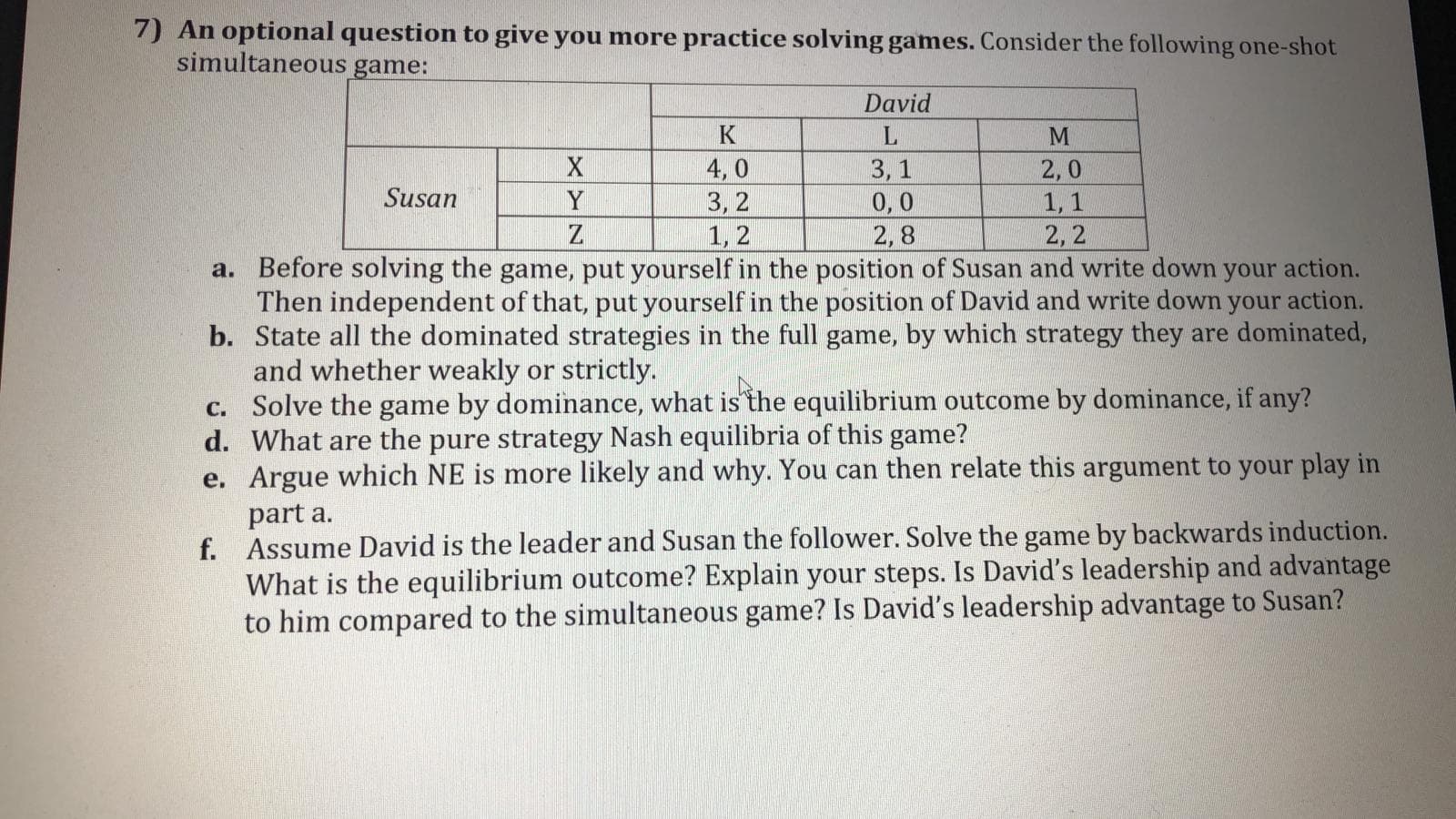An optional question to give you more practice solving games. Consider the following one-shot simultaneous game: David K L 3, 1 0,0 2,8 4, 0 3, 2 1, 2 a. Before solving the game, put yourself in the position of Susan and write down your action. Then independent of that, put yourself in the position of David and write down your action. b. State all the dominated strategies in the full game, by which strategy they are dominated, 2,0 1, 1 2,2 Susan Y and whether weakly or strictly. c. Solve the game by dominance, what is the equilibrium outcome by dominance, if any? d. What are the pure strategy Nash equilibria of this game? e. Argue which NE is more likely and why. You can then relate this argument to your play in part a. f. Assume David is the leader and Susan the follower. Solve the game by backwards induction. What is the equilibrium outcome? Explain your steps. Is David's leadership and advantage to him compared to the simultaneous game? Is David's leadership advantage to Susan?
An optional question to give you more practice solving games. Consider the following one-shot simultaneous game: David K L 3, 1 0,0 2,8 4, 0 3, 2 1, 2 a. Before solving the game, put yourself in the position of Susan and write down your action. Then independent of that, put yourself in the position of David and write down your action. b. State all the dominated strategies in the full game, by which strategy they are dominated, 2,0 1, 1 2,2 Susan Y and whether weakly or strictly. c. Solve the game by dominance, what is the equilibrium outcome by dominance, if any? d. What are the pure strategy Nash equilibria of this game? e. Argue which NE is more likely and why. You can then relate this argument to your play in part a. f. Assume David is the leader and Susan the follower. Solve the game by backwards induction. What is the equilibrium outcome? Explain your steps. Is David's leadership and advantage to him compared to the simultaneous game? Is David's leadership advantage to Susan?
Managerial Economics: A Problem Solving Approach
5th Edition
ISBN:9781337106665
Author:Luke M. Froeb, Brian T. McCann, Michael R. Ward, Mike Shor
Publisher:Luke M. Froeb, Brian T. McCann, Michael R. Ward, Mike Shor
Chapter15: Strategic Games
Section: Chapter Questions
Problem 3MC
Related questions
Question
sub-question d,e,f

Transcribed Image Text:An optional question to give you more practice solving games. Consider the following one-shot
simultaneous game:
David
K
L
3, 1
0,0
2,8
4, 0
3, 2
1, 2
a. Before solving the game, put yourself in the position of Susan and write down your action.
Then independent of that, put yourself in the position of David and write down your action.
b. State all the dominated strategies in the full game, by which strategy they are dominated,
2,0
1, 1
2,2
Susan
Y
and whether weakly or strictly.
c. Solve the game by dominance, what is the equilibrium outcome by dominance, if any?
d. What are the pure strategy Nash equilibria of this game?
e. Argue which NE is more likely and why. You can then relate this argument to your play in
part a.
f. Assume David is the leader and Susan the follower. Solve the game by backwards induction.
What is the equilibrium outcome? Explain your steps. Is David's leadership and advantage
to him compared to the simultaneous game? Is David's leadership advantage to Susan?
Expert Solution
This question has been solved!
Explore an expertly crafted, step-by-step solution for a thorough understanding of key concepts.
This is a popular solution!
Trending now
This is a popular solution!
Step by step
Solved in 2 steps with 3 images

Knowledge Booster
Learn more about
Need a deep-dive on the concept behind this application? Look no further. Learn more about this topic, economics and related others by exploring similar questions and additional content below.Recommended textbooks for you

Managerial Economics: A Problem Solving Approach
Economics
ISBN:
9781337106665
Author:
Luke M. Froeb, Brian T. McCann, Michael R. Ward, Mike Shor
Publisher:
Cengage Learning


Exploring Economics
Economics
ISBN:
9781544336329
Author:
Robert L. Sexton
Publisher:
SAGE Publications, Inc

Managerial Economics: A Problem Solving Approach
Economics
ISBN:
9781337106665
Author:
Luke M. Froeb, Brian T. McCann, Michael R. Ward, Mike Shor
Publisher:
Cengage Learning


Exploring Economics
Economics
ISBN:
9781544336329
Author:
Robert L. Sexton
Publisher:
SAGE Publications, Inc

Microeconomics: Principles & Policy
Economics
ISBN:
9781337794992
Author:
William J. Baumol, Alan S. Blinder, John L. Solow
Publisher:
Cengage Learning